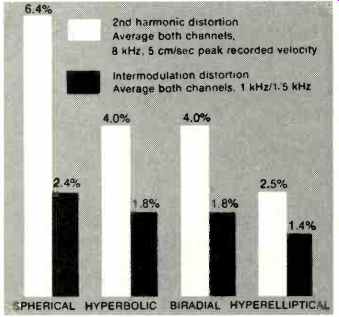fact: the IV does more... much more!

Era IV begins! The new Shure V15 Type IV phonograph cartridge is an altogether new pickup system that exceeds previous cartridge performance levels by a significant degree. It systematically solves not one, but several problems prevalent in modern disc sound reproduction:
Demonstrably improved trackability across the audible and sub-audible range at ultra-light tracking forces:
The V15 Type IV has a new stylus assembly design for dramatically increased trackability. The effective stylus mass has been lowered significantly by utilizing a telescoped shank structure and a new lightweight high-energy magnet.
The reduced effective mass of the new structure helps improve trackability in the critical mid and high frequencies. A newly designed two-function bearing system has been independently optimized for low frequencies and for high frequencies so that trackability is enhanced across the audio spectrum.

above: SYSTEM TRACKABILITY--THEORETICAL RECORDED VELOCITIES; * Cartridge-tonearm system trackability as mounted in SME 3009 tonearm at 1 gram tracking force.
The shaded area at right in the Trackability chart on preceding page represents recommended theoretical limits of record cutting velocities. However, the scattered points are the "hottest" recorded velocities actually measured on today's difficult-to track records. The new V15 Type IV tracks far more of the "hottest" points at a low stylus force than any other existing cartridge! (The curve shown is for 1 gram tracking force. By increasing this to 1 1/4 grams, even more of these points which encompass virtually all records produced thus far will be tracked.)
Dynamically stabilized tracking that overcomes record warp problems
Our war on warp...

THE V15 TYPE IV
The warp problem
Note the shaded area (at bottom left of the Trackability chart at left) which represents actual warp signals found on records, and the revolutionary sub-audible warp trackability characteristics of the SUPER TRACK IV. Reactions of the playback system to these very low frequency warps (between 0.5 and 8 Hz) existing on virtually all recordings can result in gross changes in the distance between the cartridge and the record. This distance change alters the stylus tracking force and the vertical tracking angle and can result in groove skipping, cartridge bottoming, signal wow, and even amplifier and/or speaker overload.
Trackability at all frequencies is diminished by these warp-caused changes in tracking force! Also, at some very low frequency (from 5 to 15 Hz), the tone arm-cartridge combination has a resonance frequency. When this resonance frequency is excited by the warp, all the above symptoms are intensified.
The Super Track IV total design solution:
A viscous-damped Dynamic Stabilizer on the V15 Type IV combines with a new stylus assembly to minimize or completely eliminate warp-related problems. It raises the arm-cartridge resonance frequency and attenuates the arm-cartridge system resonance effect.
An electrostatically neutralized record surface
Static charges are omnipresent and unevenly distributed on all records. These charges can attract the cartridge unevenly and change the arm-to-record distance, the vertical tracking angle, and stylus tracking force. The result is wow and flutter. Also, static discharge through the stylus and amplifying system can be a cause of annoying pops and clicks.
The Super Track IV total design solution:
Electrically conductive fibers in the Dynamic Stabilizer of the V15 Type IV ride on the surface of the record and continuously sweep the grooves just ahead of the stylus. This picks up the static electricity and discharges it to ground, much like a miniature lightning rod. The record surface is thus electrically neutralized. The static charge is prevented from affecting the arm-to-record distance, or from causing static noise in the system. Discharging the static stabilizes tracking force during the entire record playing process and does away with the electrostatic attraction of dust to the record surface.
In addition, the conductive fibers effectively sweep the record surface to remove loose dust and lint.
Ultra-flat response

above: Each V15 Type IV cartridge is individually tested for frequency response that is well within the 2 dB envelope shown here.
Dramatically reduced distortion

The Hyperelliptical nude diamond tip configuration of the V15 Type IV represents a significant advance in tip design for stereo sound reproduction. As the above figures show, its "footprint" (represented by the black oval) is longer and narrower than the traditional Biradial (Elliptical) and narrower than long-contact shapes (such as the Hyperbolic). This results in an optimized tip-groove contact area and dramatically reduces both harmonic distortion (white bars in graph) and intermodulation distortion (black bars).

above: HARMONIC AND INTERMODULATION DISTORTION FOR VARIOUS TIP SHAPES
Hear this singularly musical, technically unsurpassed, and supremely uniform new pickup system at your high fidelity dealer's showroom, or write for the complete story.
(Ask for AL 569):
Shure Brothers Inc., 222 Hartrey Avenue, Evanston, IL 60204, USA.
Manufacturers of high fidelity components, microphones, sound systems and related circuitry.
(Source: Audio magazine, May 1978)

Also see: Shure phono cartridges (Feb. 1979)
Shure phono cartridges (Feb. 1978)
= = = =
